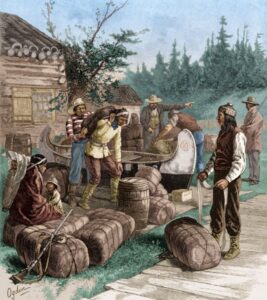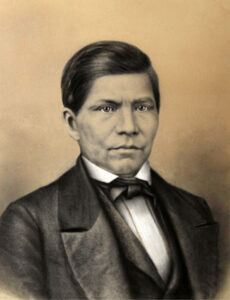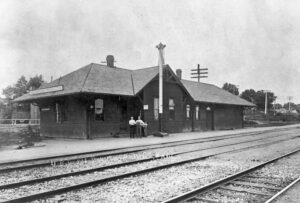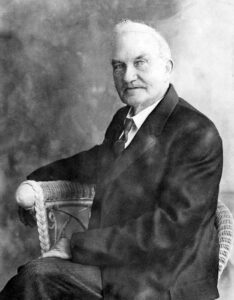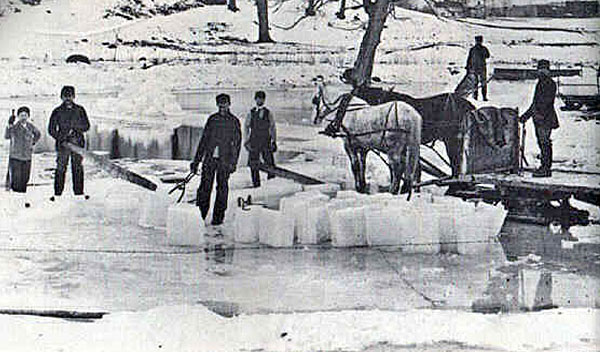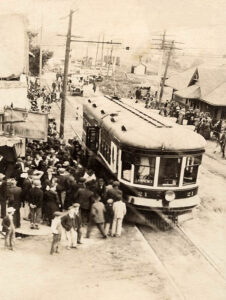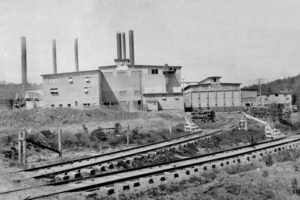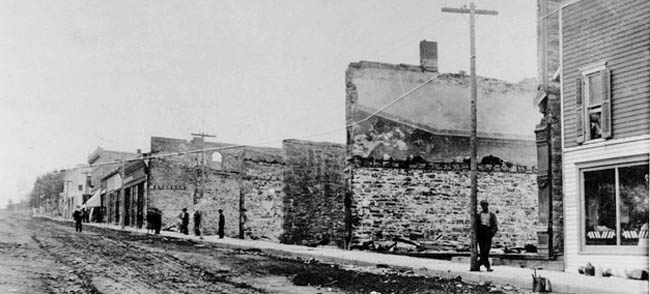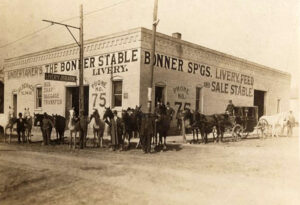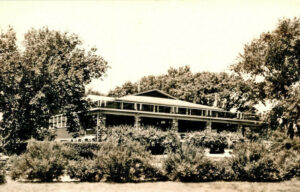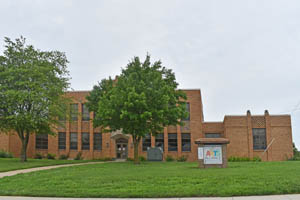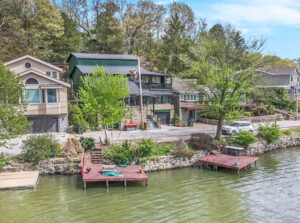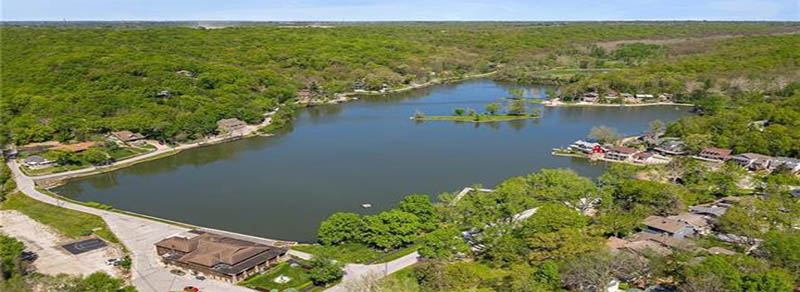Bonner Springs, Kansas, part of the Kansas City Metropolitan Area, is spread across Wyandotte, Leavenworth, and Johnson Counties. Its population, as of the 2020 census, was 7,837. Nestled among the rolling hills on the edge of the Kansas River, Bonner Springs is one of the oldest cities in the state.
The area’s early settlers were the Kanza Indians, who had lived here because of the mineral springs and abundant fish and game.
In 1812, two French fur traders, August and Pierre Chouteau, came from St. Louis, Missouri, and started a trading post called “Four Houses.” It was reputed to be the first commercial center and permanent settlement in Kansas. The “Four Houses” stood on the high ground, commanding a fine river view. They were built of logs on four sides of a square so that they could protect the fort in case of Indian attacks.
At that time, competition was stiff as the brothers competed with the large companies operating from Canada. The skins of the beaver were the most sought-after. The Chouteaus rapidly explored the country and established more trading posts along the Missouri and Kansas Rivers. The Chouteaus did extensive business at Four Houses, which continued to the time of the coming of the Delaware and Shawnee Indians and the establishment of a trading post at Secondine, now Muncie. Beaver was hunted so rapidly from one stream to another that they were decimated within 30 years.
In the early years, there were 20 springs in the area that various Indian tribes had lived around for at least part of the year. The medicine men of the Indian tribes often brought their patients to these springs for healing. When early settlers arrived, they heard many stories about the great healing power of these waters, which they named Indian Springs. The springs in the area were analyzed for their mineral content, and the results indicated benefits that would attract visitors.
In 1830, Henry Tiblow, a Delaware Indian, took charge of the ferry. Tiblow also worked as an interpreter for the government and lived in a small cabin on the west side of the present-day city. His ferry was well patronized, as there was a daily stagecoach coming and going on the road from Leavenworth to Olathe and Fort Scott, Kansas. The stage stopped here for dinner with all its passengers at a log house. His prices for crossing the river were $2.50 for a team, wagon, and man, a single being $1.25, a boatman $.50, often making $75.00 a day for weeks.
Between 1840 and 1865, steamboat traffic and the arrival of the railroads brought new people and commerce to the area.
At the close of the Civil War in 1865, the Kansas Pacific Railroad Company went to work on the grade, followed up with the tracks, and completed it to Lawrence that year. A depot was established in Tiblow, and the railroad agent attended to the company’s business and ran a general store there.
John W. McDanield, nicknamed “Red John” due to his hair color, came to Tiblow in 1865. However, he went away and came again in 1868 and began to improve his farm, which would become the townsite of Bonner Springs. His family consisted of himself, Ellen, his wife, and their son, Charles McDanield, then a small boy. As the owner of a vast majority of the land that is now Bonner Springs, McDaniel named the town Tiblow after his friend Henry.
When he arrived, several others lived in the area, including James Long, John Langston, Chalen Carter, the Sibert family, and the Swan Nilson family from Sweden. By this time, Jacob Trembley was running the ferry, and Henry Tiblow, for whom the town was named, had moved onto the farm known as the General Miller farm, where he lived, died, and was buried.
A post office opened on June 20, 1866. However, it moved to Edwardsville on January 9, 1867.
The first school taught in Tiblow was by Fannie Reed in 1867, in a building afterward called Sway Back. It stood southwest of Riverview Hotel, and she had three students. The following school was taught in 1868 in an old farmhouse.
Tiblow was officially platted in November 1870 by John McDanield and his wife, Ellen, the townsite proprietors.
With the Union Pacific Railroad built along the north side of the river and the Atchison, Topeka & Santa Fe Railroad line to Leavenworth crossing at that point, Tiblow soon grew to be a busy little town, with a brick schoolhouse, several flourishing businesses, and dwellings. The numerous fine springs of medicinal waters in and around the place suggested making it a health resort and a place for suburban residences for people engaged in business in Kansas City.
A new post office was established on June 6, 1871.
By the early 1880s, Tiblow showed signs of prosperity with a good brick schoolhouse and several flourishing businesses.
In 1885, Philo Clark purchased 300 acres from McDanield, with plans to capitalize on the mineral springs. That year, he organized the Bonner Springs Town Company.
He soon built the three-story Coronado Hotel by a 15-acre man-made lake. The hotel, with a basement and 60 rooms, cost $10,000 to build. It opened in June 1886. That month, The Topeka Daily Capital featured an article on “The new Kansas Watering Place and Health Resort: Bonner Springs.” The article announced that an auction would be held for people interested in buying lots.
On July 9, 1886, the town’s name was changed from Tiblow to Bonner Springs for a publisher of the New York Ledger, who was a trotting-horse breeder of note, because Philo Clark believed he would help fund the proposed racetrack. The idea was to encourage Bonner and other horse owners to bring their stock to race at a track north of town. To promote the springs, a special train brought investors to the area and cited its proximity to Kansas City. The springs were located in fine parks with native trees, the site of a future racetrack, and beautiful residential sites as advantages that would assure the success of the mineral spring venture. However, the track was never built.
Before long, Bonner Springs was platted into 19 blocks of various sizes, and a large body of land was developed into the beautiful Saratoga Park, which pleased the sight of passengers on the trains passing by. The company also purchased lands adjoining the town, and from time to time, new additions were laid out. The town’s growth was slow at first, although the hotel was, in the summer season, crowded with guests.
In June 1888, Forest Lake was created when Henry Harrison dammed Mission Creek to harvest ice. Harrison borrowed $20,000 from John W. McDanield, a prominent financier in Bonner Springs and Kansas City, to make the purchase. At the time of purchase, a railroad right-of-way on the property was granted to the Union Pacific Railroad. The railway had a 30-foot right of way/spur along the south side of the lake and laid up stone walls south of the lake, running east from the depot. Shortly after Harrison bought the land, he agreed with Edward Swift and the Union Pacific Railroad to build a dam on the site, creating an artificial lake to harvest ice. Harrison named the 40-acre artificial lake Lake Evelyn after his daughter. Soon, newspaper articles indicated plans to ship 100 rail carloads of ice per day in season, and a boarding house was built.
Harrison ran the operation by having the ice pulled out of the lake by horses. It was then packed in straw and put in storage houses located near the railway spur, east of the lake. This venture provided much-needed employment in the area.
A few years later, however, the land and lake were deeded to John W. McDanield because Harrison breached his contract/loan obligation. Upon ownership transfer, McDanield changed the lake’s name to Forest Lake. Ice harvesting continued on the lake until about 1909. By 1892, Swift & Company and The Armour Company installed machines to produce artificial ice. Forest Lake’s ice house was one of the largest in the country. It was reported that Swift and Company shipped a trainload of men to harvest and store the ice.
John W. McDanield also raised funds for and completed the Inter-Urban Electric Line/Kansas City, Kaw Valley, and Western Electric Railroad. In the off-season, the lake was used for summer water activities. When ice harvesting stopped in about 1909, the lake was used solely for recreational purposes.
On January 1, 1891, the Bonner Springs Sanitarium was organized to establish an institution where nervous and mental diseases of all forms could be specially treated. It was owned and managed by Dr. M.P. Sexton. A high elevation of land near Bonner Springs, overlooking the Kansas River, was selected for the site, and soon a beautiful stone structure was built. The location was perfect in every respect, the freedom from the city’s dust, heat, and bustle, with the pure, invigorating air and abundance of sunshine everywhere, bringing rest, health, and strength to the numerous patients. The building contained 50 rooms, with 400 feet of verandas. It had steam heat and was furnished with all modern conveniences.

The Falls at Lake Forest in Bonner Springs, Kansas.
In 1898, Bonner Springs became a city of the third class, and Philo M. Clark became its first mayor and served for several terms. Philo Clark was also active as the head of the Clark Real Estate Company and continued to work in the city’s best interests.
Soon afterward, natural gas was discovered in the area, and things began to change rapidly. First, a large brick plant was established east of the city limits to manufacture sand brick. Next, the attention of capitalists and manufacturers was attracted by the large deposits of shale that could be used to manufacture cement and the abundance of natural gas that was available for fuel. When the Kansas natural gas fields were developed, the gas was piped to Bonner Springs.
On July 25, 1901, McDanield, wanting to tie the surrounding area to Kansas City, deeded a 50-foot right-of-way to the Kansas City, Lawrence & Topeka Railway Company. McDanield and J. D. Waters, a prominent businessman in the area and on the Bonner Springs Board of Directors, began raising funds for the Inter-Urban Electric Line. Waters and McDanield pledged $10,000, Kansas City, Kansas merchants pledged $25,000, and the rest came from property right-of-way owners.
By 1902, the Bonner Springs Resort, including the well-kept park in which the springs were situated, had become a favorite camp-meeting spot. However, the park and resort were not public, as it was privately owned by J.W. McDanield.
Considerable improvements were made by this time. In addition to the lake, which furnished abundant facilities for boating, there was a large pavilion and several permanent buildings designed for the use of camp-meeting associations and others who tented upon these grounds. The trees were large, and many belonged to the first growth. In the lower park, a building was erected to protect visitors from the weather, and in connection with this, there was a large stand for the sale of refreshments. Near this building was a pavilion built over two of the most valuable springs. A pipeline carried the water from one of these to the pump house in the valley below the “Lodge,” where a windmill-powered pump elevated the water to the top of the “Lodge.”
In June 1903, the Missouri River crested at 34.9 feet, 12.9 feet above the natural river bank. Twenty-two thousand people were homeless, except 2,500 from the Kansas City, Kansas area. The West Bottoms, the East Bottoms, Armourdale, and North Kansas City were covered with water. Several lives were lost, and property damage was in the millions. The people of Bonner Springs did not suffer because of the city’s high elevation, but they could see it all.
Unfortunately, on July 16, 1903, the Bonner Springs Sanitarium caught fire early at about 2:00 a.m. Starting in the kitchen at the west end of the main building, the fire reached the roof of the main structure before it was discovered. With a light wind driving the blaze into the halls and rooms on every floor, the entire building was filled with smoke before the patients, some 30 in number, were awakened. When Nurse Payne went into the hall and heard Dr. Rogers calling for help, he broke the door open and led Rogers part of the way down the hall. However, he reached the porch only to find that Dr. Rogers had not followed. Later, it was found that Dr. Rogers had stopped to save a woman patient and was himself burned to death. All those burned were first suffocated, as none were heard to scream. Thirty minutes after the fire was discovered, nothing was left of the three-story building except the foundation, along with Dr. A.E. Rogers, three others died, including Captain J. A. McClure of Junction City, Kansas; Miss Jannle Campbell, a patient from lola, Kansas; and Mrs. A. A. Cook, a patient from Lawrence, Kansas.
The sanitarium was rebuilt, and in June 1905, Dr. Henry C. Hays of Bonner Springs, one of the foremost physicians of Wyandotte County, assumed the management of the sanitarium. Under his efficient control, it became one of the country’s most useful and successful institutions. In managing the Sanitarium, the Doctor had the assistance of a fine corps of skilled physicians, trained nurses, and an efficient matron.
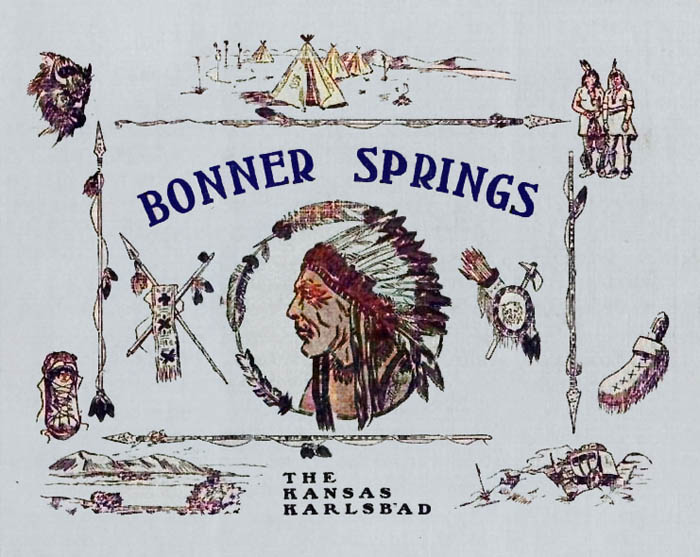
Bonner Springs, The Kansas Karlsbad.
In 1907, the Bonner Springs Improvement Club created a promotional brochure touting the city as the “Kansas Karlsbad” and listing the contents of five springs near Lake of the Woods. They listed “grains per gallon” of things like potassium sulfate, carbonate of iron, and chloride of sodium for each.
The same year, the Bonner Portland Cement Company’s plant was built a mile east of the city, one of the largest manufacturers of its kind in the world, with a capacity for making 2,500 barrels of cement each day, employing several hundred people. The company also owned several hundred acres of land along the rugged hills on the north side of the Kansas River, in which there were deposits of shale and rock sufficient to keep a great mill going for years.
The first link from Bonner Springs to Lake Forest via the Inter-Urban Electric Line was finished in December 1907. On June 18, 1908, the line from Bonner Springs to Lake Forest was completed. With the line’s completion, people from Bonner Springs came to Lake Forest for daily water activities and picnicking in the summer. There were two schedules in the morning and two in the afternoon.
By June 18, 1908, the Inter-Urban Electric Line was complete from Bonner Springs to Forest Lake, previously known as Evelyn Lake. Work began to extend the Inter-Urban to Kansas City, Kansas, Lawrence, and Topeka.
On June 24, 1908, it was announced that McDanield would sell most of his Forest Lake interests to J.D. Waters, W.H. Caffery of Bonner Springs Portland Cement Company, and L. G. Frisbie, who borrowed the money from L. P. Kindred. The following summer, 1909, the boarding house (c. 1888) added a screened porch. The porch provided an area for the new owners to open a dining hall to provide meals and lunches for picnics. The boarding house became the first community center and was the focal point of the lake’s social life. People gathered at the community center for dining, relaxation, and evening dances.
In October 1908, a fire caused over $70,000 in damage and destroyed 19 and 21 local businesses in Bonner Springs. There were no water mains at the time, even though the city council had previously debated the issue. Many locals came to the rescue, forming a water bucket chain to help extinguish the fire while waiting for a fire truck from Kansas City to arrive. An investigation indicated that materials behind Kelly & Pettit’s Drug Store had caught on fire, and the winds carried the flames, making the fire difficult to control. Afterward, residents of Bonner Springs undertook thousands of dollars worth of repairs, and Bonner Springs continued to be prosperous, with a growing population and new businesses.
June 3, 1909, McDanield sold Forest Lake to J. D. Waters, Luther Kindred, and L. G. Frisbie. That summer, a dining hall was opened that also provided lunches for picnicking.
That same year, work began to extend the Intern-Urban from Kansas City, Kansas, Lawrence, and Topeka. On August 3, 1909, W. H. Caffery, now president of the newly formed Kansas City Kaw Valley & Western Railway Company, announced to the Kansas City Star that a charter was obtained on July 28, 1909, to extend the electric railway from Bonner Springs to Topeka and from Lake Forest to 18th Street and Minnesota Avenue in Kansas City, Kansas where it would connect with the Metropolitan Street Railway. The Company intended to purchase the existing line from Bonner Springs to Lake Forest, first extending to Kansas City, Kansas, and then, if successful, to Topeka.
The interurban line was a factor in the future industrial growth of Bonner Springs in that it provided, heretofore, unavailable transportation and, therefore, an opportunity to commute to a Kansas City job. The new convenience of the electric train also acted as a stimulus to the buying and renting in Lake Forest by upper-middle-class residents of Kansas City. The small, exclusive community is situated on the ridge overlooking the Kaw Valley about two miles east of Bonner Springs.
An additional 171 acres were purchased in 1910, and a charter for “The Lake of the Forest Club” was filed with the Kansas Secretary of State.
In the summer of 1910, the Chieftain published articles billing activities at the Lake, such as tennis, golf, and water activities, “free of charge,” and stating this was the last chance for the public to enjoy recreation at the lake before it became a “private” club. At this time, Lake Forest had a refreshment stand behind the boathouse on the west shore selling ice cream and cold drinks. The boathouse and dock had 20 flat boats available for rent.
In 1910, Bonner Springs was one of the largest towns in Wyandotte County. Located on the Atchison, Topeka & Santa Fe and Union Pacific Railroads, it was surrounded by a rich agricultural district. For years, it has been the banking town for the western part of the county and the shipping point for livestock, garden produce, and fruit. In 1910, it was one of the most prosperous and thriving towns in the eastern part of the state, with excellent water, a sewer system, lighting, public school systems, paved streets, beautiful homes, and churches, retail stores of all kinds, lumber yards, and other commercial concerns. There were two express companies, telegraph and telephone facilities, and a population of 1,447.
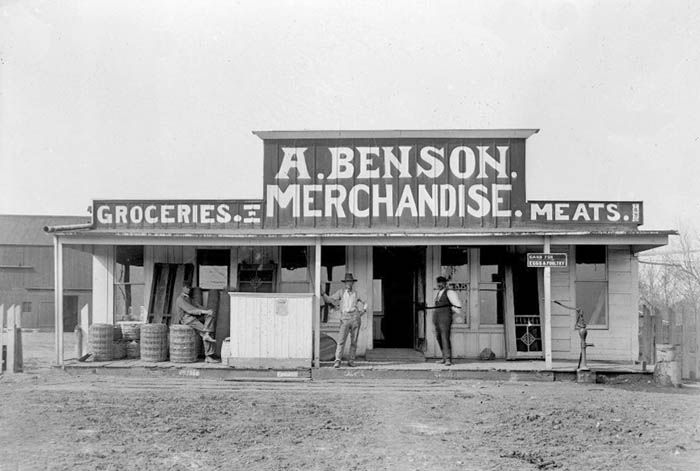
Benson’s Store in Bonner Springs, Kansas.
At that time, the Bonner Portland Cement plant supplied the town of Bonner Springs, the Gray Brick manufacturing plant, and a large sanitarium with natural gas for lighting and heating purposes. Their wells were of great depth and flowed strong and steady; the company has sufficient acreage that they are reasonably assured of having sufficient gas to last them for years innumerable.
Bonner Springs was the central point for mail delivery by the rural free delivery system for a large section of Wya dotte, Leavenworth, and Johnson Counties. It was there that the post office department established the first free delivery route in the United States. At first, it was merely an experiment, but it proved so successful that hundreds of rural mail routes were soon established in many states.
Newspaper ads from 1910 indicated that round-trip carfare from Kansas City, Kansas, to Forest Lake, the Inter-Urban Electric Line, cost 15¢ and took 30 minutes.
On December 9, 1910, Waters, Kindred, and Frisbie purchased 810 acres described in the Plat as “The Lake of the Forest Club for $50,000. The Club Charter was filed in the Secretary of State’s office the same month. Soon after the property was purchased, the stone walls were added onto, and the gatehouse, the caretaker’s house, the entrance structure, and a stone staircase were constructed.
In 1911, J.D. Waters sold common areas to the Lake of the Forest Club and held onto all the unsold lots, which were eventually sold to individuals for homes. Many of the original homes were “tent homes” and were only occupied during the summer.
The original boarding house/clubhouse was replaced in 1917 by the present-day Craftsman-style Clubhouse Pavilion. The Clubhouse underwent a renovation during the 1990s, creating a period-appropriate interior. The lower level was also brought up-to-date with the addition of a clubroom that is the home of many smaller Lake gatherings. The Clubhouse is also home to our own post office, one of only a few remaining on privately owned property.
Eventually, wood frame houses were built, but it was in the late 1920s before people began living here year-round. Many of today’s homes are additions to and remodels of the original homes.
By 1915 Club By-Laws indicated a monetary charge per Forest Lake club member, specifically for building a “Clubhouse/Pavilion.” The two-story, modified Shingle and Craftsman-style club was built in 1917. The clubhouse contained a ballroom and stage, dining room, garden room, gathering room with stone fireplace, and a post office. In about 1918, a brick pump house was built southeast of the lake and clubhouse.
Full-time residents began living at the lake between 1920 and 1925, but it was not until 1930 that several year-round homes with heat appeared. In about 1934, a fountain was placed in front of the clubhouse. By the late 1930s, Forest Lake was a full-time resident community.
The Inter-Urban Electric Line that allowed Bonner Springs to prosper carried passengers through the 1940s and freight into the 1960s.
Bonner Springs continued to grow in the following decades, and what was once a boomtown of agriculture and trade moved into a community of light industry, commercial business, and retail. No longer characterized as agricultural, this busy community now boasts a wealth of attractions, entertainment, recreational opportunities, and unique retail shopping. Because it is served by Interstate 70, US 24/40, K-7, and K-32, Bonner Springs has easy access to metropolitan Kansas City and nearby Village West, a destination for shopping, lodging, and entertainment. A golf course, two museums, 500 acres of parks and recreation, the annual Kan as City Renaissance Festival, and the Azura Amphitheatre make Bonner Springs a destination with something for everyone.
Lake of the Forest still stands on Highway 32, approximately 9/10 miles west of E Edwardsville, Kansas. What began as a recreational club developed into the planned lakefront community it is today. Life at The Lake today is not that much different from its early days, with most activities centering around the clubhouse, golf course, tennis courts, and the lake. Today, the communal properties of the Lake of the Forest are maintained through yearly club dues. The Lake of the Forest was listed in the National Register of Historic Places on January 22, 1996.
Bonner Springs is located in Wyandotte County, at the northern end of the beautiful stretch of the Kansas River, about 15 miles west of Kansas City, Kansas.
©Kathy Alexander/Legends of Kansas, updated July 2025.
Also See:
Wyandotte County Photo Gallery
Sources:
Blackmar, Frank W.; Kansas: A Cyclopedia of State History, Vol I; Standard Publishing Company, Chicago, IL 1912.
Bonner Springs-Edwardsville Chieftain, July 16, 1903
Bonner Springs History
Cutler, William G; History of Kansas; A. T. Andreas, Chicago, IL, 1883.
Kansas Geological Survey, Geology, 1902
Lake of the Forest
Lake of the Forest National Register Nomination
Morgan, Perl W.; History of Wyandotte County, Kansas and Its People, Lewis Publishing Company, Chicago, IL, 1911
Wikipedia


